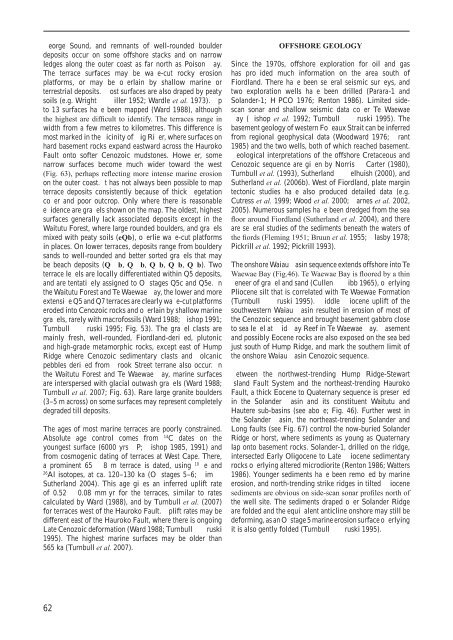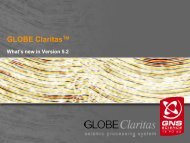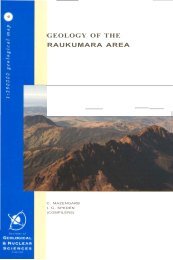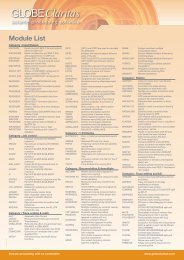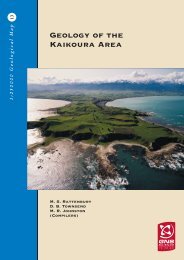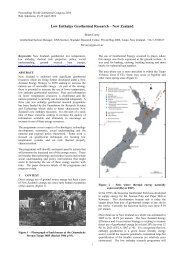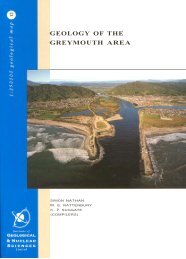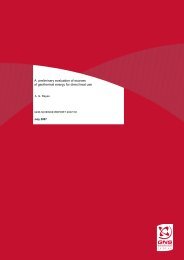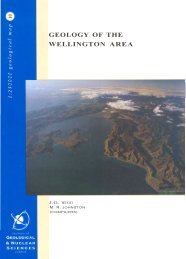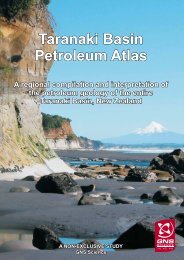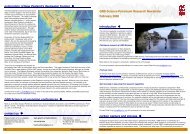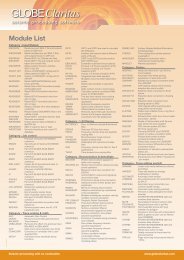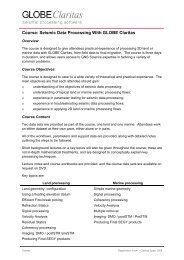Geology of the Fiordland Area - GNS Science
Geology of the Fiordland Area - GNS Science
Geology of the Fiordland Area - GNS Science
- No tags were found...
Create successful ePaper yourself
Turn your PDF publications into a flip-book with our unique Google optimized e-Paper software.
eorge Sound, and remnants <strong>of</strong> well-rounded boulderdeposits occur on some <strong>of</strong>fshore stacks and on narrowledges along <strong>the</strong> outer coast as far north as Poison ay.The terrace surfaces may be wa e-cut rocky erosionplatforms, or may be o erlain by shallow marine orterrestrial deposits. ost surfaces are also draped by peatysoils (e.g. Wright iller 1952; Wardle et al. 1973). pto 13 surfaces ha e been mapped (Ward 1988), although<strong>the</strong> highest are difficult to identify. The terraces range inwidth from a few metres to kilometres. This difference ismost marked in <strong>the</strong> icinity <strong>of</strong> ig Ri er, where surfaces onhard basement rocks expand eastward across <strong>the</strong> HaurokoFault onto s<strong>of</strong>ter Cenozoic mudstones. Howe er, somenarrow surfaces become much wider toward <strong>the</strong> west(Fig. 63), perhaps reflecting more intense marine erosionon <strong>the</strong> outer coast. t has not always been possible to mapterrace deposits consistently because <strong>of</strong> thick egetationco er and poor outcrop. Only where <strong>the</strong>re is reasonablee idence are gra els shown on <strong>the</strong> map. The oldest, highestsurfaces generally lack associated deposits except in <strong>the</strong>Waitutu Forest, where large rounded boulders, and gra elsmixed with peaty soils (eQb), o erlie wa e-cut platformsin places. On lower terraces, deposits range from boulderysands to well-rounded and better sorted gra els that maybe beach deposits (Q b, Q b, Qb, Qb, Qb). Twoterrace le els are locally differentiated within Q5 deposits,and are tentati ely assigned to O stages Q5c and Q5e. n<strong>the</strong> Waitutu Forest and Te Waewae ay, <strong>the</strong> lower and moreextensi e Q5 and Q7 terraces are clearly wa e-cut platformseroded into Cenozoic rocks and o erlain by shallow marinegra els, rarely with macr<strong>of</strong>ossils (Ward 1988; ishop 1991;Turnbull ruski 1995; Fig. 53). The gra el clasts aremainly fresh, well-rounded, <strong>Fiordland</strong>-deri ed, plutonicand high-grade metamorphic rocks, except east <strong>of</strong> HumpRidge where Cenozoic sedimentary clasts and olcanicpebbles deri ed from rook Street terrane also occur. n<strong>the</strong> Waitutu Forest and Te Waewae ay, marine surfacesare interspersed with glacial outwash gra els (Ward 1988;Turnbull et al. 2007; Fig. 63). Rare large granite boulders(3–5 m across) on some surfaces may represent completelydegraded till deposits.The ages <strong>of</strong> most marine terraces are poorly constrained.Absolute age control comes from 14 C dates on <strong>the</strong>youngest surface (6000 yrs P; ishop 1985, 1991) andfrom cosmogenic dating <strong>of</strong> terraces at West Cape. There,a prominent 65 8 m terrace is dated, using 10 e and26Al isotopes, at ca. 120–130 ka (O stages 5–6; imSu<strong>the</strong>rland 2004). This age gi es an inferred uplift rate<strong>of</strong> 0.52 0.08 mm yr for <strong>the</strong> terraces, similar to ratescalculated by Ward (1988), and by Turnbull et al. (2007)for terraces west <strong>of</strong> <strong>the</strong> Hauroko Fault. plift rates may bedifferent east <strong>of</strong> <strong>the</strong> Hauroko Fault, where <strong>the</strong>re is ongoingLate Cenozoic deformation (Ward 1988; Turnbull ruski1995). The highest marine surfaces may be older than565 ka (Turnbull et al. 2007).OFFSHORE GEOLOGYSince <strong>the</strong> 1970s, <strong>of</strong>fshore exploration for oil and gashas pro ided much information on <strong>the</strong> area south <strong>of</strong><strong>Fiordland</strong>. There ha e been se eral seismic sur eys, andtwo exploration wells ha e been drilled (Parara-1 andSolander-1; H PCO 1976; Renton 1986). Limited sidescansonar and shallow seismic data co er Te Waewaeay ( ishop et al. 1992; Turnbull ruski 1995). Thebasement geology <strong>of</strong> western Fo eaux Strait can be inferredfrom regional geophysical data (Woodward 1976; rant1985) and <strong>the</strong> two wells, both <strong>of</strong> which reached basement.eological interpretations <strong>of</strong> <strong>the</strong> <strong>of</strong>fshore Cretaceous andCenozoic sequence are gi en by Norris Carter (1980),Turnbull et al. (1993), Su<strong>the</strong>rland elhuish (2000), andSu<strong>the</strong>rland et al. (2006b). West <strong>of</strong> <strong>Fiordland</strong>, plate margintectonic studies ha e also produced detailed data (e.g.Cutress et al. 1999; Wood et al. 2000; arnes et al. 2002,2005). Numerous samples ha e been dredged from <strong>the</strong> seafloor around <strong>Fiordland</strong> (Su<strong>the</strong>rland et al. 2004), and <strong>the</strong>reare se eral studies <strong>of</strong> <strong>the</strong> sediments beneath <strong>the</strong> waters <strong>of</strong><strong>the</strong> fiords (Fleming 1951; Bruun et al. 1955; lasby 1978;Pickrill et al. 1992; Pickrill 1993).The onshore Waiau asin sequence extends <strong>of</strong>fshore into TeWaewae Bay (Fig.46). Te Waewae Bay is floored by a thineneer <strong>of</strong> gra el and sand (Cullen ibb 1965), o erlyingPliocene silt that is correlated with Te Waewae Formation(Turnbull ruski 1995). iddle iocene uplift <strong>of</strong> <strong>the</strong>southwestern Waiau asin resulted in erosion <strong>of</strong> most <strong>of</strong><strong>the</strong> Cenozoic sequence and brought basement gabbro closeto sea le el at id ay Reef in Te Waewae ay. asementand possibly Eocene rocks are also exposed on <strong>the</strong> sea bedjust south <strong>of</strong> Hump Ridge, and mark <strong>the</strong> sou<strong>the</strong>rn limit <strong>of</strong><strong>the</strong> onshore Waiau asin Cenozoic sequence.etween <strong>the</strong> northwest-trending Hump Ridge-Stewartsland Fault System and <strong>the</strong> nor<strong>the</strong>ast-trending HaurokoFault, a thick Eocene to Quaternary sequence is preser edin <strong>the</strong> Solander asin and its constituent Waitutu andHautere sub-basins (see abo e; Fig. 46). Fur<strong>the</strong>r west in<strong>the</strong> Solander asin, <strong>the</strong> nor<strong>the</strong>ast-trending Solander andLong faults (see Fig. 67) control <strong>the</strong> now-buried SolanderRidge or horst, where sediments as young as Quaternarylap onto basement rocks. Solander-1, drilled on <strong>the</strong> ridge,intersected Early Oligocene to Late iocene sedimentaryrocks o erlying altered microdiorite (Renton 1986; Watters1986). Younger sediments ha e been remo ed by marineerosion, and north-trending strike ridges in tilted iocenesediments are obvious on side-scan sonar pr<strong>of</strong>iles north <strong>of</strong><strong>the</strong> well site. The sediments draped o er Solander Ridgeare folded and <strong>the</strong> equi alent anticline onshore may still bedeforming, as an O stage 5 marine erosion surface o erlyingit is also gently folded (Turnbull ruski 1995).62


